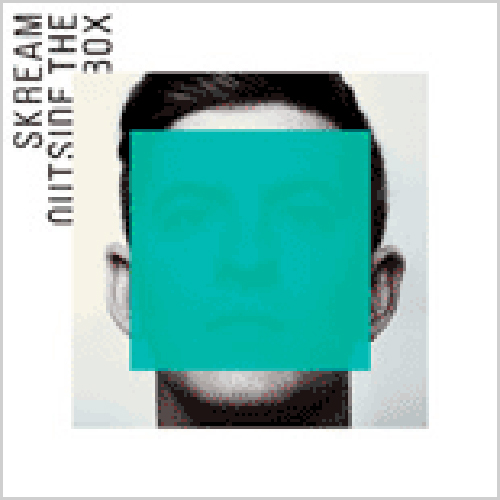SKREAM
16歳で学校を辞めてクラブと白ラベル・アナログ学科に本腰を入れた時期から今までの間SKREAMは様々なことを成し遂げてきた。
「学校は大嫌いだったし、学校も俺のこと嫌いだったよ。めったに行かなかったし、基本行きたくなかったんだ。初めてプレイステーションで音楽が作られてるのを見て、即決定だったね。他は考えられない。GCSE(イギリスの高校進学時に受ける国家試験)でAを5つ取った奴も知ってるけど今は人生がつまらなくてしょうがない顔してるよ。」
学校辞めてすぐ働いた場所が地元クロイドンのBig Apple Records(ビッグ・アプル・レコード)だった。ビッグ・アプルはストリート上がりのダンスミュージックにとっては、パンクでいうRough Trade(ラフトレード)のような存在だった。1998年当時、2ステップの売れっ子リミクサーだったArtwork (アートワーク)ことArthur Smith(アーサー・スミス)とDanny Harrison(ダニー・ハリソン)は2階にスタジオを持っていて、SKREAMとBENGAは1階の店のレジにいない時は必ずスタジオで地元の英雄達の仕事ぶりを観察していた。「店で働いてて学んだのは、知らない人間との話し方だね。土方が入ってきて2ステップ・ガレージのレコードを買いに来る時もあれば、大手流通会社が来る時もあったからね。色々違うとこ出身の違う人間に会えたんだ。」
ダブステップの初期の頃、彼とBig Appleのメンバーは自分達と周りの友達に聞かせる為に曲を作っていた。今や数千人を集める正真正銘のビッグパーティーとなった’FWD>>’も最初は20人弱で集まって曲を聴いてた。しかしそこはレジデントを勤めるDJ Hatcha(ハッチャー)が最初にSKREAMの曲をかけたイベントでもあり、本人が最初にDJした場所でもある。その音楽の純粋なパワーに惹かれ、徐々に人が増えつつ、BBC RADIO ONEのMary Anne Hobbs(メリ・アン・ホブズ)が大きく取り上げたり、ウェブ上であっという間に殺到したフォーラムが出来たりした。そんな中誰の名前が最も響いていたかと言うと、Midnight Request Line(ミッドナイト・リクエスト・ライン)といったダブステップの一番最初のヒット曲を生んだSKREAMだった。
「あの曲は初めてメインストリームの人達がアンダーグラウンドをのぞき出した頃の曲なんだ。当時はまだのぞいて「ムーブメントが起きてるんだ、へぇー」で終わってたけどね。」 そして2006年にHot Chip(ホット・チップ)の曲 ‘No Fit State’(ノー・フィット・ステート)のパーツを入手した彼はリミックスを作りクラブでかけて行った。その翌年The Klaxons(ザ・クラクソンズ)に連絡して’Not Over Yet’(ノット・オーバー・イェット)のパーツを入手して、曲の骨組みを変え、シンセや特徴的なベースを加え完全に自分の曲にした。そしてその次に来たのがかの有名なLa Rouxのリミックス。SKREAMの’In For The Kill’(イン・フォー・ザ・キル)のリミックスはウェブ上に漏れ、数万回ダウンロードされて、終いにはBBC RADIO ONEの有名DJ Annie Mac (アニー・マック)が国営放送でリスナーにその月のナンバーワンにするよう呼びかけた。
彼は昔から制作ペースは異常に早い。現在アルバムは2枚、コンピレーション2枚、2003年から合計81曲リリースしたが、DJでかけたオリジナルは数百曲ある。2007年から使っているハードディスクには872曲の未完成の曲が入っていて(2001年から2007年まで使っていたハードディスクにも同じぐらい入っている)、未だに実家の寝室にある彼のスタジオには20,000曲以上の曲データが入っている。「俺は作るのが早いんだ。作り出して25分後にそこまで面白くないと思ったら、次の曲を始めるんだ。」
Ollie ‘Skream’ Jones is on a major roll. The 24 year old Croydon DJ, producer and original dubstepper had the festival anthem of last year with his Let’s Get Ravey remix of La Roux’s ‘In For The Kill’; he’s just been featured on the cover of NME with his Magnetic Man co-stars Benga and Artwork; and as we speak, he is all over Radio 1 with the first single from his second solo album, Outside The Box. The tune in question, ‘Listenin To The Records On My Wall’, is the perfect introduction to why Skream’s current level of success is just the beginning. It’s a joyful, ragingly energetic celebration of the last quarter decade of British street music, inspired by the hardcore and jungle records used by his older brother Hijak who was part of Grooverider’s Internatty Crew. It’s also a brilliant pop record that makes perfect sense to everyone who grew up surrounded by the breaks and beats of the 1990s – and to those who didn’t.
A lot has happened since the 16 year old Skream left school with no GCSEs and a top-flight training in white labels and nightclubs. “I hated school and school hated me. I was rarely there and rarely wanted to be there. When I first saw music being made on a PlayStation, that was it. There was never going to be anything else. I know people who got 5 A-Cs but now they look like they’re dying of boredom.” He started working at Big Apple Records in Croydon, a place that holds the same place in street-up dance music as Rough Trade does in punk. Arthur ‘Artwork’ Smith and Danny Harrison, 2-Step remixers du jour circa 1998, had a studio upstairs and when Skream and Benga weren’t downstairs in the shop, they were watching and learning from their local masters at work. “The shop helped me grow up to be not a dickhead in terms of talking to people I didn’t know. You’d get builders coming in buying garage records and you’d have top distributors. I met so many different people from different places.”
In the early days of dubstep he and his Big Apple posse made music for themselves and a select band of listeners. There might have been 20 people at FWD>>, the night where resident DJ Hatcha first played Skream’s records, and where he first DJed, but it didn’t matter. Gradually, more people got involved, drawn in by the raw power of the music and well-documented tipping points like Mary Anne Hobb’s Radio 1 show and an influential online forum. And if they heard anyone, they heard Skream, who became an enthusiastic regular on the international dubstep circuit and made an early anthem in ‘Midnight Request Line’. “That tune was when people from the mainstream started looking into the underground. They weren’t embracing it, they were like ‘wow there’s this movement’… and they moved on.” Then, in 2006, he got the parts to Hot Chip’s ‘No Fit State’ and began playing it out. The following year he contacted The Klaxon’s record label for the parts to ‘Not Over Yet’, stripped it down, added synthetic rushes and major bass power, and made it his own. Then came La Roux. Skream’s now infamous remix of “In For The Kill” that got leaked, downloaded thousands of times, and then before long Annie Mac was championing it, urging listeners to get the mix to Number One.
He has always made tunes at an incredible rate: he has two albums (Skream! in 2006 and Outside The Box), two compilations and 81 tunes released since 2003 and many hundreds more he’s played during DJ sets. There are 872 finished songs on the hard drive he’s been using since 2007 (and about the same on the hard drive he used between 2001 and 2007) and at least 20,000 song files in his current studio which is still in his old bedroom at his parents house, which is useful for both continuity and tea and toast on tap. “I work at a fast rate. If I’m not into an idea after 25 minutes I start something else.”


